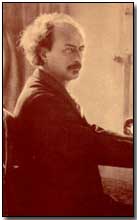Who's Who - Ignace Paderewski
 Ignace Jan Paderewski
(1860-1941) was an internationally renowned concert pianist who used his
fame to campaign - successfully - in favour of Polish independence during
the First World War.
Ignace Jan Paderewski
(1860-1941) was an internationally renowned concert pianist who used his
fame to campaign - successfully - in favour of Polish independence during
the First World War.
Born in the village of Kurylowka, Podolia on 18 November 1860, Paderewski studied at the Warsaw Musical Institute and went on to become - following brilliant debuts at Vienna in 1887 and Paris the following year - one of the world's most renowned pianists and composers. Paderewski conducted his first of many concert tours of the U.S. in 1890, a country which he came to regard as his second homeland.
With the onset of war in Europe in 1914 Paderewski became active in expounding the cause of Polish nationalism among Allied capitals, becoming in 1917 U.S. representative of the Paris-based Polish National Committee. Paderewski's work in the U.S. proved influential in persuading President Woodrow Wilson to back an independent Poland; it went on to form one of Wilson's famed Fourteen Points which formed the basis for peace in November 1918.
A signatory of the Versailles peace treaty, where he worked to negotiate Poland's borders, Paderewski served as Poland's first post-war Prime Minister. He also played a key role in defining the 1919 Polish constitution and was nominated as his country's delegate to the League of Nations (which he enthusiastically supported).
Over the course of the following two decades Paderewski remained politically active while maintaining his alternate career in music.
In 1939 Hitler's Germany invaded Poland, sparking off the Second World War. The exiled Paderewski - now aged 79 - travelled to London and served as president of the Polish National Council; in this capacity he once again set off for the U.S. to campaign once again for Polish independence.
It was while he was in the U.S. that Paderewski died on 29 June 1941, aged 80, while staying at the Buckingham Hotel. U.S. President Franklin Delano Roosevelt authorised Paderewski's temporary burial at Arlington National Cemetery until such time as his body could be returned to his homeland. This eventually took place - post-Communist Poland - on 29 June 1992, some 51 years after the date of his death, when he was given a state funeral at St John's Cathedral in Poland.
The "Blue Max" was a reference to the prestigious German Pour le Merite medal.
- Did you know?
